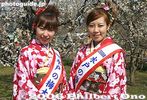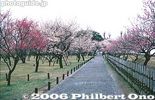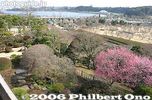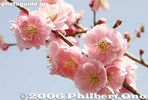 Image search results - "plum" Image search results - "plum" |

Hanegi Park is near Odakyu Umegaoka Station ("Umegaoka" means plum hill). 小田急梅ヶ丘駅
|
|

Welcome to IbarakiTrain platform of Kairakuen Station.
|
|

Yoshino Baigo was a valley and hillside covered with ume plum trees. It boasted a wide variety of different plum blossoms. During full bloom as you can see here, the scenery was spectacular. One of the largest plum groves in Japan.Platform of Hinata-Wada Station with welcome banner 日向和田駅. Banner says, "Yokoso, Ume no Sato Yoshino Baigo." Yokoso means "welcome," and Ume no Sato means "plum town."
To get to Hinata-Wada, you have to change trains at Ome Station on the JR Chuo Line.
|
|

Entrance to Hanegi Park's plum grove
|
|

Train platform of Kairakuen Station
|
|

Closest train station is Hinata-Wada Station. To get to Hinata-Wada, you have to change trains at Ome Station on the JR Chuo Line. 日向和田駅Sadly, spring 2014 was the last time we could see these trees. The plum trees were infected by the plum pox virus and the city cut down all the trees in 2014 to wipe it out. These photos were taken in 2006 when the plums were still fully glorious. Good news is that they have been replanting since 2016.
|
|

The plum trees are on a small hill.
|
|

Train platform of Kairakuen Station
|
|

Although still small, the replanted plum trees have been flowering. and the groves have reopened to the public. Yoshino Baigo poster. Yoshino Baigo is a small town in Ome city near Hinata-Wada Station.
|
|

Hanegi Park has plum blossoms in mid-Feb. to early Mar. It has about 700 plum trees and also sports facilities and public library.
|
|

Plum Blossom Queen at Kairakuen StationShe was passing out maps of the garden. It was a nice touch to see two of these kimono beauties greeting us.
|
|

Road to Yoshino Baigo. Almost the entire town is lined with plum trees.
|
|
|
|

Plum Blossom Queen
|
|

Tamagawa River as seen from the bridge.
|
|
|

Entrance to garden via Tokiwa Shrine. One of Japan's three most famous gardens, Kairakuen is especially noted for thousands of plum blossom trees which bloom in Feb. and March.One of Japan's three most famous gardens, Kairakuen is especially noted for thousands of plum blossom trees which bloom in Feb. and March.
|
|

Plum trees line the streets
|
|
|

Tokiwa Shrine, MitoDedicated to Lord Mitsukuni Tokugawa, the second lord of Mito, and Nariaki Tokugawa, the ninth lord of Mito and the one who built Kairakuen Garden.
|
|

Yoshino Baigo's main attraction is the Ume no Koen plum park. This is an entrance leading to the park.
|
|
|

Bonsai plum treesI bought one of these once and the flowers smelled good before they withred away. The tree also died soon afterward.
|
|

Ume no Koen park straight ahead, you can see the hill covered with white.
|
|
|
|

Crowd at Higashi-mon East GateThis was the defacto main gate and most crowded since it is closest to the train station.
|
|

Entrance to a temple with a view
|
|

Way to Mogusaen Garden
|
|

Picnic area
|
|

Map of Kairakuen, a garden built in 1841 by Tokugawa Nariaki (1800-1860), the ninth Lord of Mito. It is one of Japan's three most famous gardens.
|
|

Great view from temple (no admission charge). Sadly, this is no more...
|
|

Decorating the path to Mogusaen Garden
|
|

Stone monument for "Haru no Tsuki" haiku poem by Nakamura Teijo. 「春の月」中村汀女
|
|

Pinickers
|
|

View from temple. The plum pox virus was discovered in 2009. Since then, they have cut down the infected and surrounding trees.
|
|

Long uphill slope will keep you panting until the garden entrance.
|
|

Stone monument for "Haru no Tsuki" haiku poem by Nakamura Teijo. 「春の月」中村汀女
|
|

Plum blossom-viewing picnickers
|
|
|

Entrance to Mogusaen Garden
|
|
|
|

Red and white plum blossoms
|
|

About 120 varieties of plum blossoms are planted, attracting 60,000 to 100,000 visitors during the flowering season.
|
|

Steps to garden
|
|
|
|
|

Near the entrance to Ume no Koen plum blossom park that opened in March 1972.
|
|
|

Weeping plum blossoms
|
|

White plum blossoms, the most common variety, and with the sweetest aroma.
|
|

Ume no Koen (Plum Park) is a public park open from 9 am to 5 pm.
|
|
|
|
|

200 yen admission charged during March only. But I went on April 1 so it was free (and full bloom).
|
|

Shoren'an which is now a restaurant. 松連庵
|
|
|

Osaka-zuki red plum blossoms 大盃Osaka-zuki
大盃
|
|

White weeping plum blossoms
|
|

Plum tree and Shoren'an
|
|
|

Plum tree grove, about a week too early.
|
|

Red weeping plum blossoms at park entrance
|
|

One of the few plum trees in bloom in early Feb.
|
|

Flower pair
|
|

Fantastically-shaped plum tree
|
|

Red weeping plum blossoms
|
|

Plum blossoms
|
|

Near park entrance
|
|

Konan Shomu plum blossom 江南所無Prunus mume Kounanshomu
|
|

Red weeping plum blossoms
|
|
|

Plum Blossom Queens in Kairakuen, Mito
|
|

Pink and white weeping plum blossoms
|
|
|

Plum Blossom Queens in Kairakuen, Mito
|
|

White weeping plum blossoms
|
|

Centerpiece plum tree but too early for flowers. 寿昌梅
|
|
|

Pink weeping plum blossoms
|
|

Shoren'an and picnic tables
|
|

Plum trees and Lake Senba
|
|

With about 1,300 plum trees, this park is probably Tokyo's largest plum tree grove.
|
|

View of the city
|
|

Plum trees and Lake Senba
|
|

Work of art by nature
|
|

Plum trees and Lake Senba
|
|

Path in plum park
|
|
|
|
|
|

Torano-o plum blossom (Tiger's Tail) 虎の尾
|
|

Path on hillside of plum trees
|
|

Pine trees and plum trees
|
|

Hillside plum trees
|
|

Plum tree grove
|
|

White plum blossoms
|
|

Plum tree and train
|
|

The park has about 120 varieties of plum blossoms. You can see how different they look.
|
|

Monument proclaiming Kairakuen as one of Ibaraki's 100 Best Sights
|
|

The fragrance is also different. I smelled most of them, and well on my way to becoming a connoisseur of plum blossom fragrances.
|
|

Poem monument
|
|

Perhaps the most common species of plum blossom.
|
|
|
|

Closeup of white plum blossom
|
|

Photogenic pink plum tree
|
|

Closeup of red plum blossom
|
|

Photogenic pink plum tree
|
|

Yellow plum blossoms
|
|
|

Rare plum tree with both pink and white blossoms. It has one branch with pink flowers. Never saw that before.
|
|

Yellow plum blossoms
|
|
|
|
|

Plum grove
|
|

Map of garden
|
|
|
|

Path to natural spring
|
|

These red ones also smell very nice. Different from the white ones.
|
|

Natural spring (cold water)
|
|
|
|

Bamboo grovePine trees, bamboo, and plum blossoms are called Shochikubai in Japanese. This trio of trees is most famous.
|
|
|

Omote-mon GateThis supposed to be the front gate.
|
|
|
|

Kobuntei Villa has exquisite Japanese-style paintings on paper sliding doors. Kobuntei was damaged by the March 2011 Tohoku earthquake and was closed until early 2012 for repairs.
|
|

View from one observation rest house
|
|
|

Kobuntei Villa was originally built in 1842 by Tokugawa Nariaki (1800-1860), the ninth Lord of Mito. It was his summer villa.
|
|
|

Kobuntei Villa, fusuma sliding door with painting of plum trees
|
|
|

Kobuntei Villa, fusuma sliding door with painting of azalea
|
|
|

Kobuntei Villa, fusuma sliding door with painting of fall leaves
|
|
|

In the rear of Ooagata Jinja Shrine, a Plum Garden on a slope.
|
|

Kobuntei Villa
|
|

Path going further up the hill
|
|

Ooagata Jinja Shrine Plum Garden 梅園
|
|

Kobuntei Villa
|
|
|

Weeping white plum blossoms on a slope. 梅まつり
|
|

Kobuntei Villa
|
|

Needless to say, the entire place was filled with sweet fragrance.
|
|
|

Kobuntei Villa, fusuma sliding door with painting of maple leaves
|
|
|

Weeping white plum blossoms
|
|

Kobuntei Villa
|
|

Spectacular view
|
|

Weeping white plum blossoms 白梅
|
|

Kobuntei Villa
|
|
|
|

Kobuntei Villa
|
|
|
|
|

Kobuntei Villa
|
|

Path going further up the hill
|
|

Beautiful weeping pink plum blossoms
|
|

Kobuntei Villa
|
|

Rest house at top of the hill
|
|

Weeping pink plum blossoms
|
|

Kobuntei Villa, fusuma sliding door with painting of cherry blossoms
|
|

View from top
|
|
|

Kobuntei Villa
|
|

Weeping plum blossoms at the top of the plum tree "waterfall."
|
|
|

Cherry Blossom Room, Kobuntei Villa
|
|

A "waterfall" of weeping plum blossoms しだれ梅の滝
|
|

View of shrine from plum garden
|
|

Kobuntei Villa
|
|

Weeping plum trees part of the "waterfall"
|
|
|

Kobuntei Villa
|
|

A "waterfall" of weeping plum blossoms (Shidare ume no taki) しだれ梅の滝
|
|
|

Kobuntei Villa
|
|

Yoshino Baigo plum trees
|
|

Plum blossoms bloom in mid-March
|
|

Kobuntei suffered quite a bit of damage during the big earthquake on March 11, 2011. Repairs have started in Sept. 2011, and they hope to reopen the Kobuntei by Feb. 2012.
|
|

Spectacular viewpoint
|
|
|
|
|
|
|
|
|
|
|
|

Wish the sweet fragrance could come through your computer screen...
|
|
|
|

The park is 35,000 sq. meters.
|
|
|
|
|
|
|

View from the top floor of Kobuntei Villa
|
|

Notice the plum blossom "waterfall" on the left.
|
|
|

View from the top floor of Kobuntei Villa
|
|

Minabe in Wakayama Pref. is the only place where I saw more plum blossoms than this.
|
|
|

View from the top floor of Kobuntei Villa
|
|
|
|
|

View from the top floor of Kobuntei Villa
|
|
|

View of Komaki from the plum garden.
|
|

This one is nicknamed "Married couple" blossom because it looks like two flowers have fused as one.
|
|

View of Komaki from the plum garden.
|
|

Inside the top floor of Kobuntei Villa
|
|
|

Mochi-nage area.
|
|

Balcony on the top floor of Kobuntei Villa
|
|

I think the white ones smell the sweetest...
|
|

Entertainment after the Honen Festival
|
|
|
|
|

Meitetsu Railway Gakuden Station, nearest to Ooagata Shrine. 楽田駅(がくでん)
|
|
|
|
|

Gakuden Station platform
|
|

Kobuntei Villa
|
|
|

Gakuden Station platform
|
|

Kobuntei Villa
|
|
|

Kobuntei Villa
|
|

Cherry blossom-type plum blossom called "sakura-bai." 桜梅
|
|

Closeup of "sakura-bai." Very beautiful. 桜梅
|
|

The reds and whites contrast well with the dark greens...
|
|
|

Rest house
|
|

Marker commemorating a "Plum Summit" held in Ome by representatives of cities well-known for plum blossom gardens, such as Mito, Ibaraki; Atami, Kanagawa; and Annaka, Gunma.
|
|
|

Another tree with photogenic blossoms
|
|

Photogenic blossoms
|
|
|
|
|

Fluffy blossoms
|
|
|
|
|
|
|
|
|

There's a Web site that shows the condition of the blooming blossoms every day during March. So you know when to go.
|
|
| 1146 files on 5 page(s) |
1 |
 |
 |
|